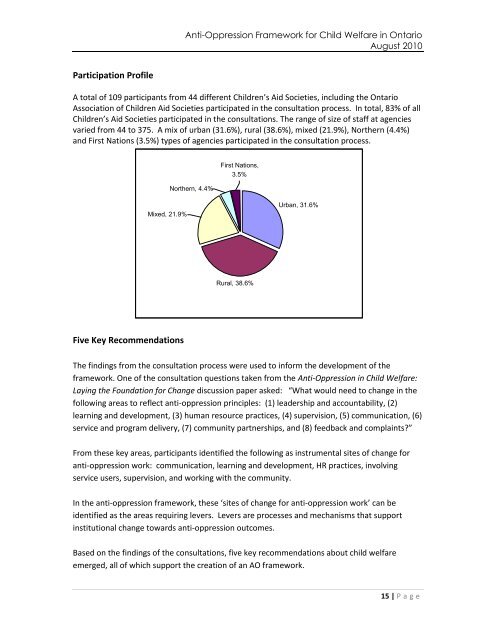B. The Consultation ProcessPurpose<strong>An</strong>ti-<strong>Oppression</strong> <strong>Framework</strong> <strong>for</strong> <strong>Child</strong> <strong>Welfare</strong> <strong>in</strong> <strong>Ontario</strong>August 2010Accord<strong>in</strong>g to Henry & Tator (2006, p. 305), <strong>Child</strong>ren’s Aid Societies are organizations that have“a socio-political system <strong>in</strong> which people act together under an imposed structure and ideologyand use a specific set of technologies to achieve a specific objective.” The socio-political systemset out <strong>in</strong> child welfare can be arranged to adopt more <strong>in</strong>clusionary practices or, can by default,ma<strong>in</strong>ta<strong>in</strong> the status quo, and thus be explicitly exclusionary by not address<strong>in</strong>g obvious structural<strong>in</strong>equalities. By seek<strong>in</strong>g various stakeholders’ <strong>in</strong>put on what anti-oppression means <strong>in</strong> childwelfare, we were able to devise mean<strong>in</strong>g to the organizational practices that are currentlycarried out <strong>in</strong> various <strong>Child</strong>ren’s Aid Societies.The development of the framework was <strong>in</strong><strong>for</strong>med by a prov<strong>in</strong>ce-wide consultation process withthose work<strong>in</strong>g <strong>in</strong> child welfare. The consultation process sought their op<strong>in</strong>ions about “what” ananti-oppression framework would look like, along with “how” it could be implemented andsusta<strong>in</strong>ed.The results of the consultations affirmed that participants were ready to critically exam<strong>in</strong>e theirown agencies, structures and processes. Why? It is because these structures, policies andprocesses <strong>in</strong> child welfare agencies that appear seem<strong>in</strong>gly fair and neutral (Yee, 2005), <strong>in</strong> fact,may be unwitt<strong>in</strong>gly impos<strong>in</strong>g oppressive practices upon families and children.MethodologyConsultations were held <strong>in</strong> each of the prov<strong>in</strong>cial zones between the months of December 2009and February 2010. Specifically, they <strong>in</strong>cluded Central, Grand River, South West, Eastern, Northand North East zones, plus one consultation with the <strong>Ontario</strong> Association of <strong>Child</strong>ren AidSocieties. <strong>Child</strong> welfare leaders, <strong>in</strong>clud<strong>in</strong>g executive directors, human resource directors anddirectors of services were <strong>in</strong>vited along with front-l<strong>in</strong>e and manager colleagues. All participantsof the consultations were provided, <strong>in</strong> advance, with a copy of the <strong>An</strong>ti-<strong>Oppression</strong> <strong>in</strong> <strong>Child</strong><strong>Welfare</strong> - Lay<strong>in</strong>g the Foundation Change: A Discussion Paper prepared by The <strong>Ontario</strong> <strong>Child</strong><strong>Welfare</strong> <strong>An</strong>ti-<strong>Oppression</strong> Roundtable <strong>in</strong> October 2008 (Grant & Ojo, 2008).The consultation process was conducted by two rotat<strong>in</strong>g facilitators from the <strong>Child</strong> <strong>Welfare</strong> <strong>An</strong>ti-<strong>Oppression</strong> Roundtable. Detailed notes were taken by another Roundtable volunteer. Therewere 13 consultations <strong>in</strong> total, most of which were divided <strong>in</strong>to separate sessions <strong>for</strong> seniorleaders and other staff. Each consultation process took approximately 2 hours. See AppendicesA and B <strong>for</strong> a list of the consultation questions as well as key f<strong>in</strong>d<strong>in</strong>gs that helped <strong>in</strong><strong>for</strong>m thedevelopment of the AO framework.Although there was participation from all zones <strong>in</strong> the consultation process, the f<strong>in</strong>d<strong>in</strong>gsrepresent the views only of those who participated. Every ef<strong>for</strong>t was made to solicit a widevariety of representation via email, networks, <strong>in</strong>vitations from zone directors and other usualcommunication venues. Note that Aborig<strong>in</strong>al populations did participate <strong>in</strong> the consultationprocess; however, their unique issues are not covered with<strong>in</strong> the scope of this report.14 | P a g e
<strong>An</strong>ti-<strong>Oppression</strong> <strong>Framework</strong> <strong>for</strong> <strong>Child</strong> <strong>Welfare</strong> <strong>in</strong> <strong>Ontario</strong>August 2010Participation ProfileA total of 109 participants from 44 different <strong>Child</strong>ren’s Aid Societies, <strong>in</strong>clud<strong>in</strong>g the <strong>Ontario</strong>Association of <strong>Child</strong>ren Aid Societies participated <strong>in</strong> the consultation process. In total, 83% of all<strong>Child</strong>ren’s Aid Societies participated <strong>in</strong> the consultations. The range of size of staff at agenciesvaried from 44 to 375. A mix of urban (31.6%), rural (38.6%), mixed (21.9%), Northern (4.4%)and First Nations (3.5%) types of agencies participated <strong>in</strong> the consultation process.Northern, 4.4%First Nations,3.5%Mixed, 21.9%Urban, 31.6%Rural, 38.6%Five Key RecommendationsThe f<strong>in</strong>d<strong>in</strong>gs from the consultation process were used to <strong>in</strong><strong>for</strong>m the development of theframework. One of the consultation questions taken from the <strong>An</strong>ti-<strong>Oppression</strong> <strong>in</strong> <strong>Child</strong> <strong>Welfare</strong>:Lay<strong>in</strong>g the Foundation <strong>for</strong> Change discussion paper asked: “What would need to change <strong>in</strong> thefollow<strong>in</strong>g areas to reflect anti-oppression pr<strong>in</strong>ciples: (1) leadership and accountability, (2)learn<strong>in</strong>g and development, (3) human resource practices, (4) supervision, (5) communication, (6)service and program delivery, (7) community partnerships, and (8) feedback and compla<strong>in</strong>ts?”From these key areas, participants identified the follow<strong>in</strong>g as <strong>in</strong>strumental sites of change <strong>for</strong>anti-oppression work: communication, learn<strong>in</strong>g and development, HR practices, <strong>in</strong>volv<strong>in</strong>gservice users, supervision, and work<strong>in</strong>g with the community.In the anti-oppression framework, these ‘sites of change <strong>for</strong> anti-oppression work’ can beidentified as the areas requir<strong>in</strong>g levers. Levers are processes and mechanisms that support<strong>in</strong>stitutional change towards anti-oppression outcomes.Based on the f<strong>in</strong>d<strong>in</strong>gs of the consultations, five key recommendations about child welfareemerged, all of which support the creation of an AO framework.15 | P a g e
















